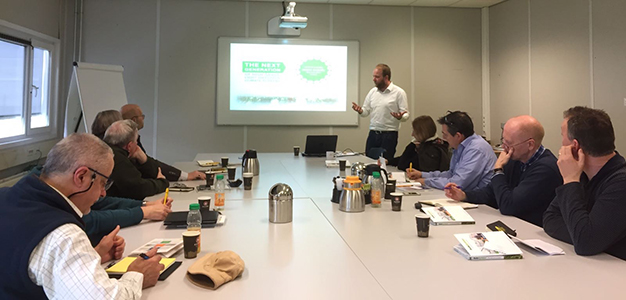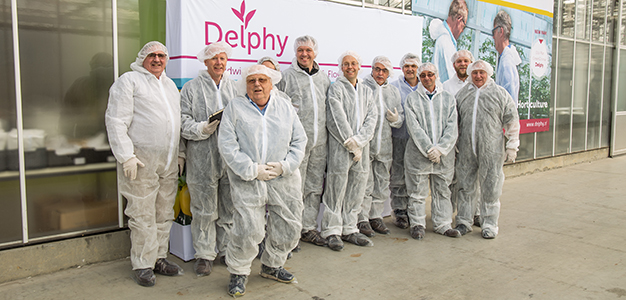English growers get an enriching learning experience about diffuse light and screens
What is the best way for flower growers, suppliers and cultivation spokesmen to learn about screening and diffuse light? By seeing it in action! In March, Ton Habraken, a consultant at Svensson - took a group of English customers to various research projects/facilities and a Phalaenopsis greenhouse.
Healthier crops with diffused light
The light-diffusing Harmony screen is an ideal option for horticulture screens. Svensson introduced a new generation of Harmony screens with improved light-diffusing properties last year. Compared to first the generation of Harmony screens, new Harmony screens take diffuse light to the next level, allowing plants in shade spots to receive up to 32% more light. This results in fewer light level spikes, enabling you to let in more (diffuse) light.
Direct light mainly hits the top of the plant, which often tends to cause heat stress and other detrimental effects from direct radiation. For instance, potted plants will dry out extremely fast and will experience sunburn as a result of the higher temperatures where the sun hits the most intense on top of the plant heads. “I have measured temperatures of 21°C (69.8°F) degrees on the north side of the pots, compared to much higher temperatures of 39°C (102.2°F) on the south,” tells one of the visitors. This problem can be resolved with diffuse light, as this allows for light to be distributed equally.
More light and optimal temperature
Diffuse light reaches the entire plant. The overall plant temperature will be closer to the ambient temperature in the greenhouse. The bottom leaves will remain fresh and active thanks to diffuse light. The light efficiency is, therefore, higher with greater photosynthesis and thus more growth than in direct light. Further, research shows that anthuriums can handle twice as much light if it is diffuse light, reducing the cultivation period by 25% with 20% heavier plants. Bromelia does not have this effect but allows for a lot more plants per m2.
Diffuse glass allows for a slight diffusing of the light, after which Harmony ensures optimal diffusion and distribution. There will be no higher temperatures underneath the open structure screen. Ton Habraken: “The ‘ventilation capacity’ of the screen is greater than the ventilation of the greenhouse.”
The next generation of bell pepper cultivation
The Delphy Improvement Centre located in the Netherlands are testing various screen uses. The English visitors were introduced to The Next Generation Growing for bell peppers, which aims to increase the energy efficiency of bell pepper cultivation. Last year, there was a trial conducted using double layer Svensson energy screens: Luxous 1547 D FR on top, and Luxous 1147 FR underneath. The top screen (the Luxous 1547 D FR) is a transparent energy curtain with light diffusing properties, and the bottom curtain (Luxous 1147 FR) is the most transparent screen on the market and provides the maximum amount of light without losing out on energy savings or humidity transport. Thanks to the increased transparency, the screens were able to remain closed longer than planned during the day.
The use of both screens allowed for a record number of screen hours and the energy targets were easily achieved. The cultivation had a total consumption of 17 m3 gas, compared to the usual 35 to 40. The production was above average and the quality was perfect.
This test will be repeated in 2017, but with three screens: three layers of the crystal-clear energy screen Luxous 1147 FR. The goal: less than 15 m3 of gas consumption. The use of screens are a key part of The Next Generation Growing. “If you are interested in this, you should apply it step by step,” advises Habraken. “Don't do it all at once, but learn to use it.”

Focus on energy saving
Research into growing the perfect Chrysanthemum is focussed on energy savings by using three screens: an Obscura screen for short day control and Luxous 1147 FR energy screen, and a Harmony screen which provides 23% shade during the daytime. Chrysanthemums are typically grown in a high-tech environment with LED's and air handling units without minimum set tube temperatures.
This energy-efficient concept pursues a 5% higher production compared to the current approach, without affecting the quality; with use of heating up to 15 m3 gas/m2/year and a CO2 use of up to 25 kg/m2/year. A hybrid lighting system is used for the cultivation with an equal input but a different number of micromoles: 65 µmol/m2.s SON-T lighting and 100 µmol/m2.s LED lighting. Red lamps were placed in order to analyze if they delay the blooming.
A similar test was also performed for roses underneath diffuse glass. After three years with SON-T lighting with high heat production, there is now a full LED lighting system with three different color formulas.
Overall, the English visitors were highly impressed by how Piko used the different screens in each of the different cultivation phases to achieve optimal energy savings.

“With Svensson's newest climate screen, HARMONY 1315 O FR, lighting tomato growers can get through the worst of climates, even a record hot summer like in 2018,” says greenhouse climate consultant Joost Haenen.
The new open climate screen offers benefits not only for the plants, but also for the working climate conditions. The best part of this new screen is that it makes chalking or coating unnecessary.
The major challenge in every crop lies in the realization of a good assimilate balance. In other words, the production of assimilates (controlled by irradiation) and the consumption of assimilates (depending on temperature) must be in balance. During a heat wave such as our past summer, the temperature is high, and therefore the consumption of assimilates is high. Too high consumption of assimilates comes at the expense of the roots. Weak or uneven root growth can lead to quality problems and water stress during a heat wave with a lot of radiation, causing high evaporation. This will close the stomata. However, open stomata are necessary for CO2 absorption. As a result, not only growth comes to a halt, but also less moisture enters the greenhouse air. This can easily be avoided with the right ventilation strategy but preventing plant stress is even better. The Harmony 1315 O FR summer screen has been developed for this purpose.
Specially for exposed tomato cultivation
High light levels and air permeability are unique to the Harmony 1315 O FR summer screen. When closed, it provides a slight shadow effect (13% in direct light) and a very high diffusivity. The screen has been specially developed for illuminated tomato growing. Tomatoes can have a lot of light, but at some point, they can't handle it anymore. This climate screen has been developed to remove the sharp edges. Especially in the scarce warm months, April to July, when the plant is old and has long stems.
“Tests at the Improvement Center have shown that the plant does not have to evaporate as much on an extremely sunny day with the new screen. The water consumption is then approximately 20% lower, which means that the root quality remains better due to oxygen retention in the mat. The open structure is also unique, ensuring that there is more than enough air exchange. That's why it's a perfect screen for the summer," says climate consultant Joost Haenen. “Moreover, the cultivation plan changes from tomato. Lighting growers are planting plants earlier and earlier, sometimes in August or even in July. Small plants then have a hard time due to the high radiation and temperature. During this period, the climate screen can easily be used to keep the plant in balance."